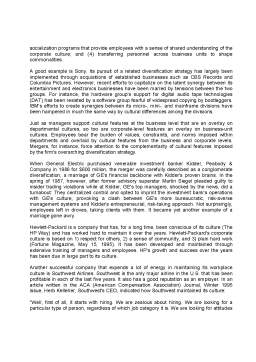Extras din referat
Definition.
Organizational culture, or corporate culture, comprises the attitudes, experiences, beliefs and values of an organization.
It has been defined as "the specific collection of values and norms that are shared by people and groups in an organization and that control the way they interact with each other and with stakeholders outside the organization. Organizational values are beliefs and ideas about what kinds of goals members of an organization should pursue and ideas about the appropriate kinds or standards of behavior organizational members should use to achieve these goals. From organizational values develop organizational norms, guidelines or expectations that prescribe appropriate kinds of behavior by employees in particular situations and control the behavior of organizational members towards one another." (Hill & Jones, 2001)
Senior management may try to determine a corporate culture. They may wish to impose corporate values and standards of behavior that specifically reflect the objectives of the organization. In addition, there will also be an extant internal culture within the workforce.
Work-groups within the organization have their own behavioral quirks and interactions which, to an extent, affect the whole system. Task culture can be imported. For example, computer technicians will have expertise, language and behaviors gained independently of the organization, but their presence can influence the culture of the organization as a whole.
http://en.wikipedia.org/wiki/Corporate_culture
Cultural perspective on organizations.
The concept of organizational culture was in common use in the 1980s. Organizational
research originally focused strongly on the surveying of corporate climate, but in the
1980s the organizational climate concept was to some extent replaced by concept of
Organizational culture. Climate was redefined as the visible expression of organizational
Culture (see e.g. Glendon & Stanton 2000, p. 198). There is no generally accepted
definition of either concept, even though both terms have been in use for more than a
decade (see e.g. Smircich 1983 and Alvesson & Berg 1992, Moran & Volkwein 1992).
organizational culture is said to mean, for example, an organization’s values (Deal &
Kennedy 1982), an organization’s generally accepted system of meaning (Pettigrew
1979) or an organization’s operating philosophy (Ouchi 1981). Despite the uncertainty
of the concept’s definition, the significance of culture is understood, particularly in the
corporate world. Traditional mechanistic management models have been found to be
inadequate and contrary to fundamental human nature. A new concept was needed to
describe and explain individuals. actions in an organization so that their working
capacity could be improved (Alvesson & Berg 1992).
http://virtual.vtt.fi/inf/pdf/tiedotteet/2002/T2140.pdf
Classifying organizational culture.
Several methods have been used to classify organizational culture.
1.Hofstede
Geert Hofstede demonstrated that there are national and regional cultural groupings that affect the behavior of organizations.
2.Deal and Kennedy
Deal and Kennedy defined organizational culture as “the way things get done around here”. They measured organizations in respect of:
- Feedback - quick feedback means an instant response. This could be in monetary terms, but could also be seen in other ways, such as the impact of a great save in a soccer match.
- Risk - represents the degree of uncertainty in the organization’s activities.
3.Charles Handy
Charles Handy (1985) popularized a method of looking at culture which some scholars have used to link organizational structure to Organizational Culture.
4.Edgar Schein
Edgar Schein, an MIT Sloan School of Management professor, defines organizational culture as "the residue of success" within an organization. According to Schein, culture is the most difficult organizational attribute to change, outlasting organizational products, services, founders and leadership and all other physical attributes of the organization. His organizational model illuminates culture from the standpoint of the observer, described by three cognitive levels of organizational culture.
The Hofstede Model.
There have been some recent models created to attempt to study and classify cultural diversity. One model, the Hofstede Cultural Orientation Model, as reported in the Spring 1995 issue of the ACA Journal, classifies cultures based on where they fall on five continuums.
1. Individual vs. Collective Orientation
The level at which behavior is appropriately regulated
2. Power-Distance Orientation
The extent to which less powerful parties accept the existing distribution of power and the degree to which adherence to formal channels is maintained.
3. Uncertainty-Avoidance Orientation
The degree to which employees are threatened by ambiguity, and the relative importance to employees of rules, long-term employment and steady progression through well defined career ladders.
4. Dominant-Values Orientation
The nature of the dominant values - e.g., assertiveness, monetary focus, well-defined gender roles, formal structure - vs. concern for others, focus on quality of relationships and job satisfaction, and flexibility
5. Short-Term vs. Long-Term Orientation
The time frame used: short-term (involving more inclination toward consumption, saving face by keeping up) vs. long-term (involving preserving status-based relationships, thrift, deferred gratifications).
There's some debate over whether companies should design their personnel policies and reward systems around cultural values. Currently companies tend not to, because of the concern about stereotyping certain cultures.
Preview document
Conținut arhivă zip
- Corporate Culture
- CORPORATE CULTURE.doc
- Corporate Culture.doc






























